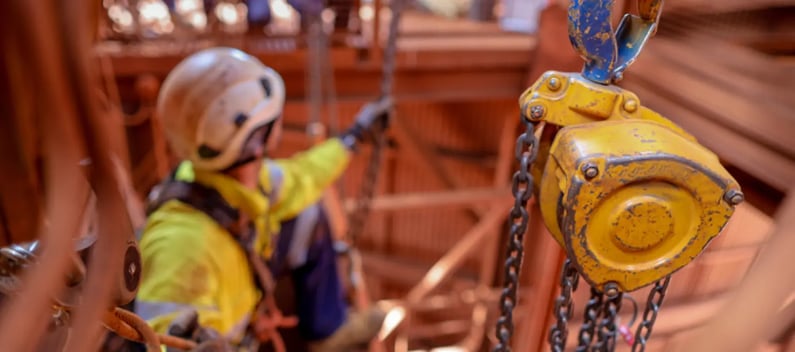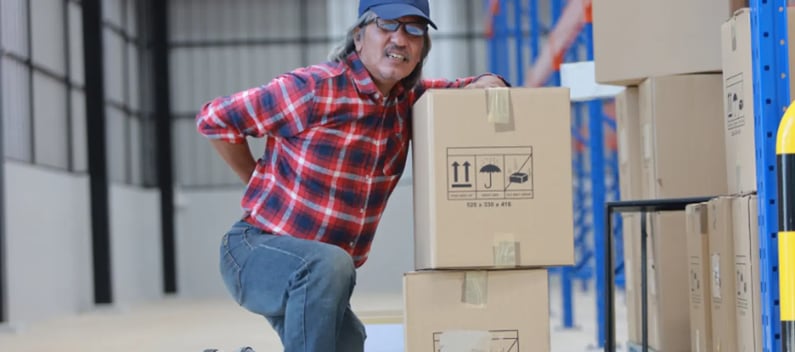One of the common types of injury sustained in work environments is known as a musculoskeletal disorder. These account for around a third of all workplace injuries and are very commonly caused due to poor handling techniques when lifting or moving objects. The purpose of this article is to discuss some of the basic advice that exists to make manual handling safer and to give an overview of the legislation in place that is of relevance to workers and employers.
What is the Manual Handling Operations Regulations 1992 (MHOR)?
The MHOR was created to manage and standardise Manual Handling Training. It provides three aspects for employers to manage before their employees carry out any work involving manual handling. These are:
1) Making a suitable and sufficient risk assessment of any risks associated with injuries that could stem from unavoidable manual work.
2) Reducing injury risks as much as reasonably possible. Wherever practicable, use mechanical assistance methods (such as sack trolleys or hoists). If using such systems is impossible in the circumstances, then an employer must show that they have explored making changes to the task, environment, or the load being moved.

Hoists and other forms of mechanical assistance help to reduce injuries.
3) Avoiding any hazardous manual handling tasks to remove the need to move the load, or otherwise make the process of moving it automated or mechanically assisted.
While these regulations form the basis for any strategy to deal with manual handling, employees are still required and expected to follow certain common-sense practices in the workplace. For example, they must:
1) Cooperate with employers on issues involving health and safety
2) Properly use equipment that is provided for their safety
3) Take care to make sure their activities don’t put other workers at risk
4) Inform their employers of any observed hazardous handling practices or standards
5) Follow guidelines and systems provided, like equipment, for their own safety
Ways to minimise risk when manual handling
Managing and thus reducing risks is simple, often hinging on common sense. The first step to take is to decide if something needs to be moved in order to do the intended work. The heavier a load is, the more likely injury is, especially if the object weighs over 20-25kg or has to be moved far or frequently. If it is machinery, for example, is it possible or easier to move raw materials directly to the object? If so, you may not be required to move it at all.
Secondly, switching to automation where possible removes a lot of the traditional risks associated with lifting or moving loads. Mechanical systems such as conveyor belts, lift trucks, or hoists, mean that a worker is not moving the object unassisted. However, if automation is an option, the risks associated with them specifically have to be considered. Appropriate training is required to use lift trucks, and any types of machinery require cleaning and maintenance that could be risky.
A good way of establishing what the main sources of risk are is by speaking to the people who work with them. Thinking about and understanding the processes, activities, and substances found in your workplace that could harm employees will reduce the risk of harm involved with any work.
Employers should question employees in order to get their input on what they observe to be hazardous and work with them to establish safe practices to mitigate the risks. Doing so also helps make you aware of any special requirements some workers, such as younger or inexperienced ones, may have, allowing particular practices to be put in place for their benefit.

Employers should establish safe practices with employees to mitigate potential risks.
Make sure any workers are aware of manufacturers' instructions when it comes to mechanical assistance equipment. They should also be made aware of the data sheets provided for chemical containers so that the risks are properly understood.
Finally, while more advanced training must be provided for when mechanical aides are used, there is still basic training that should be provided to employees to prepare them for manual handling work properly. This training should explain the risks of lifting or moving, and how injuries can occur. Critically, it should also demonstrate good handling techniques.
What are safe handling techniques?
Safe handling techniques are very simple, but they are extremely effective at reducing risks. When lifting an object, the safe way to handle it starts with planning the lift. If it is particularly heavy, do you have a place to stop midway and adjust your grip? Should you use any form of mechanical aid?
Next, it is important to remove any obstructions to the object, such as wrapping. Following this, a stable position should be adopted. Ensure appropriate footwear with a good grip is worn, and be prepared to adjust the position of feet during the lift to maintain stability. Hug the object as close to the body as is comfortable, as this provides more friction than simply holding with the hands. Do not flex the back while lifting, and make sure you start from a position that slightly bends the back, hips, and knees. Squatting or stooping to pick something up can cause a lot of damage if the object is too heavy or you try and lift it too quickly.

Avoid actions that may cause injury to yourself or colleagues.
While carrying a load, avoid leaning or bending the back. Turning by moving the feet is much safer, and you should keep your shoulders facing the same direction as your hips. Move smoothly, keeping the object close to the waist to stabilise the centre of mass by keeping the heaviest side near the body. Finally, make sure to always look forward while carrying a load - looking down and not paying attention will lead to not being able to avoid obstacles.
Flexebee offers a Manual Handling of Objects Awareness training course for those working in a care environment that are regularly exposed to heavy lifting. This accompanies our Moving and Handling of People Awareness e-learning course, which focuses on the correct and safe way to move patients. Both are available as one-off courses or as a subscription-based service. For more training opportunities like these, take a look at our Health and Safety Essentials courses.

-1.webp?width=243&height=74&name=Logo%20R%20Homepage%20White%20Final%20Horizontal%20Large%20NEW%20small%20(2)-1.webp)

-1.webp?width=50&height=59&name=Cyber%20Essentials%20Badge%20Large%20NEW%20(72dpi)-1.webp)
COMMENTS